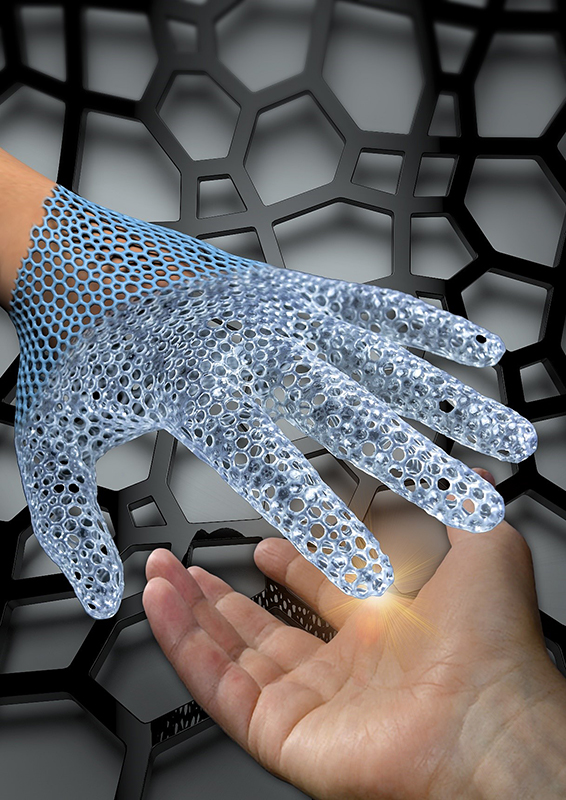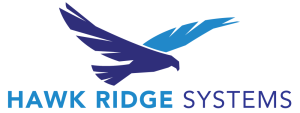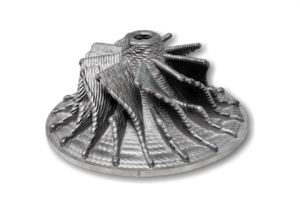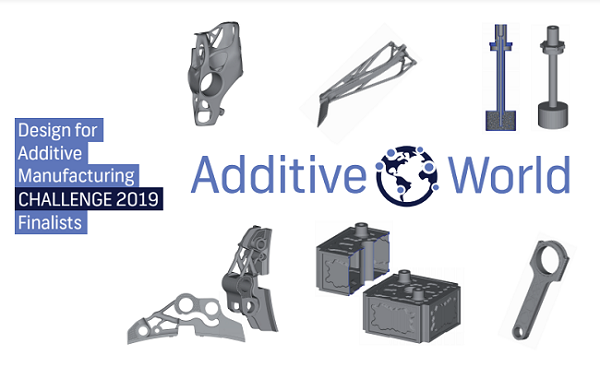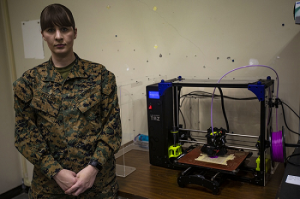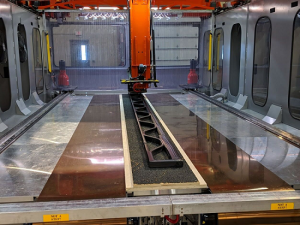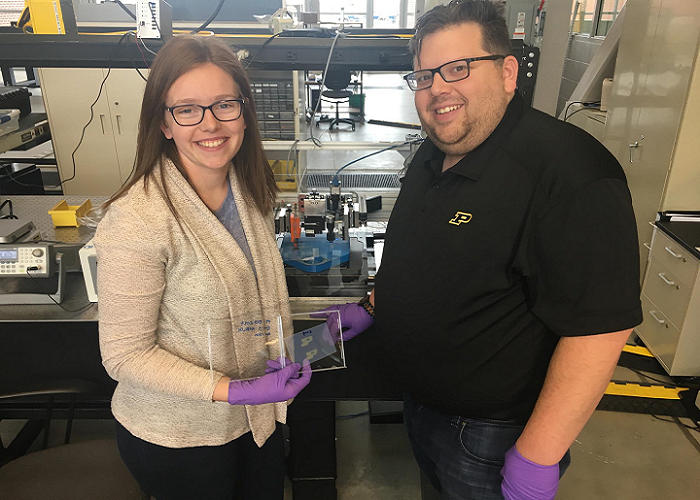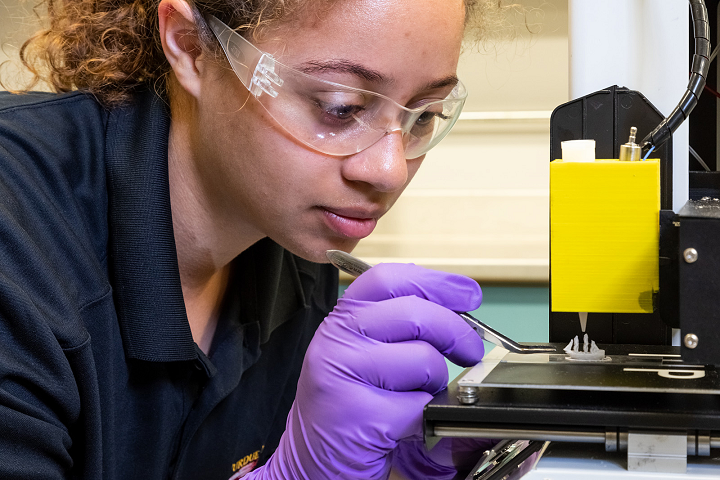During the Additive Manufacturing Symposium at this week’s Science in the Age of Experience held in Boston, Dassault Systèmes brought together a well-curated group of industry experts to share a depth of experience and insights. With plenary session and breakout presentations targeting both broad and deep dives into applications and real-world adoption, attendees were treated to discussions focusing on progress and challenges as well as application-specific issues in industrial 3D printing.

L-R: Eduardo Barocio, Thomas Marchand, Andy Kalambi, John Laureto, Shawn Ehrstein, SeanMcCluskey
A panel discussion closed out the engaging Additive Manufacturing Symposium plenary session, featuring a conversation moderated by Dassault Systèmes’ Subham Sett with
Sett began the chat by asking where 3D printing is going, turning first to Kalambi for the manufacturer’s perspective.
“The first way is the easiest: take what you’re doing in subtractive and design it for additive; that’s the low-hanging fruit. The real value is in what we’re hearing in this conference: reduce complexity, change the supply chain. How do you print the parts as close as possible to the point of consumption? We’re looking at a digital supply chain, and taking additive into that, driving business model innovation,” Kalambi said, highlighting the new partnership between Rize and Azoth for indirect supply focus. “That’s where the biggest value is.”
There is great value in bringing additive manufacturing into business strategies, but barriers to adoption remain. Sett asked McCluskey for his perspective regarding these. Tracing back to a “small history lesson” in mistrust in the industry following high-profile acquisitions and failures to deliver, McCluskey noted that there are “still remnants of mistrust today” that are negatively impacting potential adoption.
“The single biggest gap, the shortcoming that will interfere with getting to these goals is that information and innovation happening is isolated; because of that mistrust, it’s being hoarded,” he explained. “We need to bridge those gaps, to bring innovation to the public space to work on the same problems with the same information. Hoarding information — and I’m using hoarding as a negative, though it’s not necessarily; look at IP — but good or bad, it’s slowing us down.”
Another barrier, Ehrstein added, comes in the form of regulation. Particularly for highly regulated industries such as aerospace and medical, parts qualification is a major hurdle to overcome.
“Getting the FAA to accept 3D printed parts on a critical structure is important. We saw Airbus, and obviously we use these parts; people want to use these parts even more. Getting those processes developed is a barrier,” he said. “In addition, we’re facing supply chain issues. If it starts getting bigger, who’s going to be out there supplying? If it starts getting bigger, will we have the supply chain to do it? And where is the workforce coming from? Where are the people who know how to design for these processes, to run the machines?”
Also highly sensitive to qualification and regulation is the medical sector, as Marchand weighed in.
“Certification is important. Looking at ISO standards, at reaching consistent quality, it’s pretty challenging,” he said. “Certifications in the medical space are as complicated as the aviation market.”

Sett kept the conversation moving amidst attendees
In addition to these barriers, discussion touched on simulation as a driver for evolution of technology and for eventual certification, as Barocio noted, in many respects representing a journey that has just started. Continuing to look forward, Sett asked about new technologies, and Kalambi touched on 3D printing as a platform with three “stacks”: hardware, software, and materials.
“For hardware, we see more and more hybridization will happen. Singular technologies are not solving all the big problems; hybridization will be the only way to solve some of these problems,” Kalambi said. “In software, there is a need for us to move forward, to digitally connect. Looking at materials, in polymers alone there are 60,000 plastics in the world. Focus has to be about innovating on the material, to mimic as wide a spectrum as possible to address possible use cases. Innovation is happening at each of these three levels.”
In the face of this “boatload of new technology coming out,” Sett asked, is the workforce keeping up? How can it? What steps ahead are necessary?
Workforce is certainly a critical issue facing the growing additive manufacturing industry, as companies and professional organizations are well aware. Education and training are imperative to upskill the workforce and prepare the next generation of engineers and designers, along with every other personnel aspect of manufacturing, for these new technologies.
“Workforce is an issue throughout engineering anyway,” Ehrstein remarked, “and on top of that with the oncoming technology of additive manufacturing as it keeps advancing faster than software can keep up with, than people can keep up with, workforce will remain an issue.
“We’re not the only school focusing on workforce; high schools are focusing on additive and growing up with additive. Everyone’s aware of additive manufacturing coming up. I have students whose first thought is, ‘I can just go print it,’ and that’s something I had to get used to thinking and other engineers had to get used to thinking. The problem is, with new technologies coming out every day, with new companies coming out with new technologies: what is the student actually learning?”
He continued, noting that the specifics of what can be done on each machine vary between technologies and between different system models. In order to meet the needs of the industry, he said, we need to find out what the industry is doing on these machines, which poses an ongoing challenge. Progams are in place, including at the WSU-affiliated NIAR, and these are constantly evolving.
All of the changes in the shape of industry impact the broader supply chain as well, Sett noted, moving the conversation forward. The main issue here, McCluskey said, comes in terms of volume. With advanced technologies come advanced materials; McCluskey used the example of polypropylene, which is commercially available at about 71 cents per pound. In contrast, he pointed to the equivalent supply of resin for a Carbon system at “more like $71 per pound,” adding that it wasn’t a perfect compoarison, but helps to get the point across. There are not, he summed up, enough tier one suppliers to supply all these materials right now.

Kalambi discussing supply chain strategy during Rize’s press conference with new partner Azoth
Kalambi additionally pointed to the supply chain issue of building in trust. While many companies are increasingly focusing on blockchain and other advanced solutions for ensuring that IP remains secure, there is certainly much more work to be done in this area. The fast-moving industrial 3D printing market requires more solutions, and needs them soon.
“Today has had a lot of bubble-popping moments,” McCluskey said. “Here’s topology optimization; it’s great, but let’s pop that bubble. A lot of these issues aren’t new — look at anisotropy. It’s the same issues. They take time, absolutely… and it’s the same problem we’ve had forever. We need to address this on a much faster time scale for this process. We have the tools to address them, it just takes time.”
To wrap up the conversation, Sett turned to a much-used term being bandied about in 3D printing: democratization.
3D printing is frequently said to be democratizing manufacturing, putting manufacturing capabilities in the hands of a broader potential user base and enabling more in terms of agility. He turned to each panelist to ask for their final thoughts on this topic. McCluskey began, looking at the issue philosophically.
“Did the internet democratize data, or did it make it harder to find the information we need?” he asked. “You can put 3D printers in everyone’s garage, but the limiting factor is still the democratization of information and how to use it. For me, the journey has been about finding the right balance — yes, there are all these holy grail things additive manufacturing offers… We need to look how to address it in the short- mid- and long-term.”
Ehrstein continued, touching on a popular misconception lingering around 3D printing.
“There’s a lot of thinking out there that you just set out your machine and press print, and boom. There are a lot of processes, there are a lot of machines, and it takes someone a year of experience before they can legitimately create consistently good parts on that machine. You have to make the investment on training, the investment on time and experience. If you’re a small company thinking about going additive, before you make that investment into these machines that can go into a million-plus dollars, I personally think you’re better off using the supply network out there first. See how the parts work, how much the parts work, before you make that investment,” he said. “There’s the thinking that when I have that machine I can just have him print that part out over there, and the truth is if you’re not running those machines every day, it takes some time before you get to that point.”

Laureto discussing powder bed metal technology during a manufacturing breakout session
Laureto picked up from there, noting that at Renishaw, they constantly deal with the cost of entry as a barrier to adoption. This is of course not limited only to initial investment, but to continuing costs of operation.
“Economic analysis is needed,” he reaffirmed. “Do all that work up front. Try to work with everyone to find that type of solution. Because not only do you buy that machine, you fill it with $60,000 worth of titanium monthly.”
Another barrier stands in the way of the typical requirements for industrial machinery, including safety equipment, proper ventilation, and the necessary physical footprint. Kalambi addressed this issue from the perspective of an industrial desktop 3D printer manufacturer known for its ease of use and environmental friendliness.
“That question is why we’re in business: to democratize, to take industrial additive manufacturing to where it has not been before. I have seen that this business has not scaled because of this question,” he said. “Working with masks and gloves limits who can go there, and this limits adoption. We have a machine that requires no venting, and can run safely on the floor here; we believe that it should be like what was mentioned here, pervasive enough that people can set up microfactories. This is where 3D printing has to go.”
Turning to the medical sector, we see that issues are a bit more specialized. Speaking to the life science point of view, Marchand noted that hospitals have a huge need, as 3D printing can be applied to synthetic organs, to prostheses, and more.
“Every hospital would like to have a 3D printing lab, and some do. The thing is, it’s painful to have a 3D printing lab. We know that because we have two, one in the US, and one in France,” he said. “We had to go to market this way, and had no one to help us this way, to manufacture up to standards all the time. We are seeing democratization of 3D printing in hospitals, but many machines right now are not very reliable, post-processing is a problem, and you need the right people. There are still many problems to tackle.”
Barocio had the final word in the discussion of democratization, and took the opportunity to offer some advice.
“My recommendation for the additive manufacturing journey is: simulation could be a heavy investment, and something in the long term will help to come up to speed faster, also lowering the costs of trials and errors,” he said. “I really recommend to use simulation, not only hardware.”
The overall tone of the discussion remained conversational, as these various perspectives came together to offer a quick picture of a fast-growing industry and technology still enduring its growing pains. The points raised offered plenty of food for thought — among many great minds in hardware, software, materials, and end-use applications set to continue driving advances apace.
Discuss Dassault Systèmes, industry challenges, and other 3D printing topics at 3DPrintBoard.com or share your thoughts in the Facebook comments below.
[All photos: Sarah Goehrke]
 Researchers have patented promising new robotics technology created through the Purdue Office of Technology Commercialization, and outlined in ‘3D Architected Soft Machines with Topologically Encoded Motion.’ Authors Debkalpa Goswami, Shuai Liu, Aniket Pal, Lucas G. Silva, and Ramses V. Martinez have developed robotic devices that can be 3D printed and customized by users, depending on their needs.
Researchers have patented promising new robotics technology created through the Purdue Office of Technology Commercialization, and outlined in ‘3D Architected Soft Machines with Topologically Encoded Motion.’ Authors Debkalpa Goswami, Shuai Liu, Aniket Pal, Lucas G. Silva, and Ramses V. Martinez have developed robotic devices that can be 3D printed and customized by users, depending on their needs.